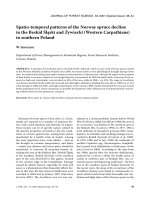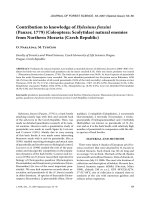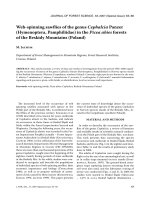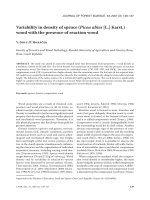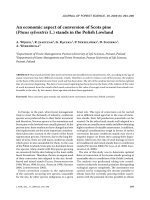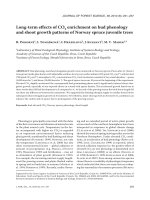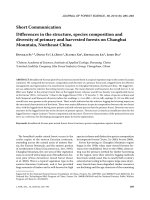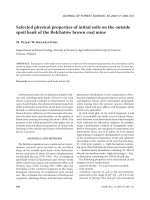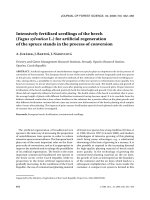Báo cáo lâm nghiệp: "This special issue of the Journal of Forest Science is a result of the international conference Species Diversity, Population Structure and Impact of Animals and" pdf
Bạn đang xem bản rút gọn của tài liệu. Xem và tải ngay bản đầy đủ của tài liệu tại đây (114.69 KB, 1 trang )
2 J. FOR. SCI., 53, 2007 (Special Issue): 1–2
Preface
is special issue of the Journal of Forest Science is a result of the international conference Species Di-
versity, Population Structure and Impact of Animals and Fungi on Forest Functions in Anthropogenically
Affected Spruce Forests held in Frýdek-Místek, Czech Republic, October 2–4, 2007.
e main aim was to present results achieved in the framework of Research Project No. MZe 0002070201
of the Ministry of Agriculture of the Czech Republic Stabilization of Forest Functions in Biotopes Dis-
turbed by Human Activities under Changing Environmental Conditions.
is project consists of six mutually connected partial intentions and each of them is further divided into
3–6 thematic domains. Partial intention 02 Species Diversity, Population Structure and Animal and Fungi
Influence on Forest Functions in Anthropogenically Affected Biotopes is focused on forest biodiversity with
an emphasis on mountain spruce forests. e study includes species compositions of some insect and fungi
groups, bionomics of the particular species and interaction between pests and environmental conditions.
e plenary session of this conference was divided into several sections: (i) Bark beetles, (ii) Sawflies,
(iii) Other insects, (iv) Phytopathological fungi. irty-one participants from three countries – Forestry
and Game Management Research Institute in Jíloviště-Strnady (Czech Republic), National Forest Centre
– Forest Research Institute in Zvolen (Slovakia), Forestry Research Institute in Cracow (Poland), Mendel
University of Agriculture and Forestry in Brno (Czech Republic), Czech University of Life Sciences in
Prague (Czech Republic), Institute of Forest Management in Brandýs nad Labem (Czech Republic) – at-
tended the conference and 14 contributions were presented. All of them were presented orally and we
introduce the most important ones as scientific articles in this book.
is conference also resulted in a future collaboration agreement on some selected survey tasks: spruce
bark beetles, larch bark beetle, mycorrhizae problems and oak decline. ese problems are widespread
throughout all three countries, hence their solving seems very important for foresters in Central Europe.
Close collaboration among all three forest research institutes has existed for many years, whereas coop-
eration with universities and with the Institute of Forest Management started only a couple of years ago
and has rather an informal character.
Our excursion to the foot of the Moravskoslezské Beskydy Mts. was an opportunity to visit forest spruce
plantations inoculated by myccorhizal fungi at the edge of the area of spruce decline. Furthermore, par-
ticipants could see these problems in the centre of the declining spruce area, namely in the forest district
Město Albrechtice, where local foresters are solving them intensively and actively by using the knowledge
of different forest management ways based mainly on natural processes. In accordance with Manion’s
theory, the decline of spruce forest is probably a result of several preconditions (spruce is allochthonous
in the area of interest, soil acidity, nutrient deficiency, water deficit, mechanical damage caused by log-
ging machines, chronic insect – tenthredinid infestation during the last 50 years, pathogen damage by
the honey fungus) and immediate damage factors. e fitness of forest stands, decreased by drought, is
further stressed with insufficient water supply as a consequence of torn roots during soil drying. Fungal
infection is inevitable afterwards. Moreover, massive attacks of honey fungus are often followed by bark
beetle colonization in these forest stands. Pityogenes chalcographus and Pityophthorus pityographus are
the most abundant in young forest stands while species of the genus Ips (Ips duplicatus, Ips typographus,
Ips amitinus) together with Pityogenes chalcographus are predominant in mature forests. Our second
excursion to the Litovelské Pomoraví Protected Landscape Area led us into oak forests wrestling with
analogical problems.
Acknowledgements
is conference as well as the majority of scientific papers was supported by Project No. MZe 0002070201
of the Ministry of Agriculture of the Czech Republic Stabilization of Forest Functions in Biotopes Dis-
turbed by Human Activities under Changing Environmental Conditions.
I would like to thank very much local foresters, particularly Ing. V Z (Forest District
Město Albrechtice, Forests of the Czech Republic (Lesy České republiky), state enterprise), Ing. J P-
(Forest District Šternberk, Forests of the Czech Republic, state enterprise) for guiding our field excur-
sions, V Ď for her technical support and organization of the conference and all anony-
mous reviewers of presented scientific articles.
Jaroslav Holuša

